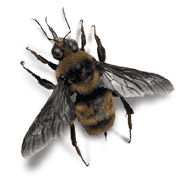Most Dangerous Insects

Mosquitos, flies, bees and wasps, and other insects
by David Johnson |
 Aggressive "killer bees" deliver a nightmarish, agonizing death by swarming all over their victim. In the Southwest, they have killed animals as large as horses. Profiles of Dangerous AnimalsAnimals
Related Links |
Mosquitos
The deadliest creature on earth, the anopheles mosquito, is responsible for more than 300 million cases of malaria each year, and causes between one and three million deaths. Malaria affects 10% of the world’s population, making it the leading mosquito-borne disease. The 3,000 species of mosquito, including some 200 in North America, do not all carry the same diseases. Mosquitos can also carry dengue and yellow fevers, encephalitis, elephantiasis, and canine heartworm.
Mosquitos are most active at night. You can reduce the risk of being bitten by wearing repellent and long sleeves. Emptying standing water in outdoor containers, cleaning gutters, changing birdbaths frequently, and keeping swimming pools properly treated helps reduce mosquito breeding areas.
Flies
Houseflies can spread some 200 pathogens and parasites to humans. The tsetse fly is another dangerous variety, spreading sleeping sickness. Caused by a parasite, sleeping sickness enters the central nervous system where it causes deep coma and death. About 250,000 to 300,000 people die each year in Central Africa from sleeping sickness.
Bees and Wasps
There are 20,000 species of bee, including social, solitary, and parasitic. Bee attacks generally occur when people stumble into a nest or otherwise provoke bees. Africanized honeybees, also known as ‘killer bees,’ are an exception. They were created when African bees were brought to Brazil in 1956 to breed a better honeybee. The effort failed and the bees escaped. They have killed 1,000 people as they have moved north through Central America to the southwestern U.S. The aggressive Africanized bees deliver a nightmarish, agonizing death by swarming all over their victim. In the Southwest, they have killed animals as large as horses.
There are also about 20,000 species of wasp, including hornets and yellow jackets. Unprovoked wasp attacks are very rare. Wasps usually sting to subdue prey or in self-defense. People may be stung if wasps have been attracted to their food, or they have inadvertently disturbed a nest. Unlike bees, wasps can sting repeatedly, however.
Other Insects
Bedbugs, parasitic worms, and fleas are also leading killers of humans. Fleas spread by rodents cause plague. In the 14th century, plague killed three-quarters of the population of Europe. Plague is rare today and can usually be treated.
Sharks, snakes, sea wasps, and blue-ringed octopuses | Introduction |







